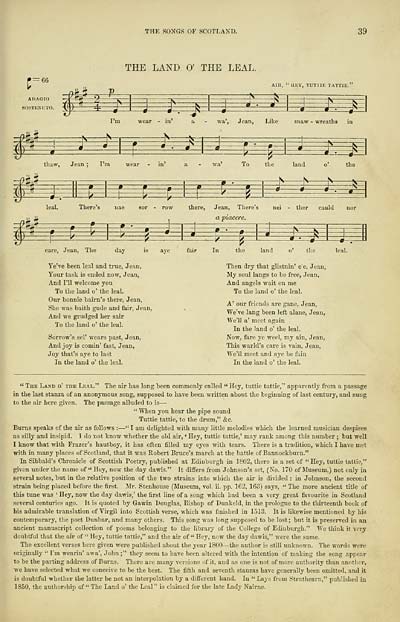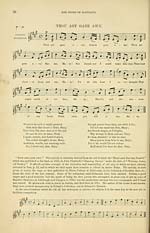Glen Collection of printed music > Printed music > Wood's edition of the songs of Scotland
(63) Page 39 - Land o' the leal
Download files
Complete book:
Individual page:
Thumbnail gallery: Grid view | List view

THE SONGS OF SCOTLAND.
39
THE LAND 0' THE LEAL.
: 66
BOSTENUTO.
nfl-n-P-
AHt, " UEY, TDTI1E TATTIE.'
-K ^i 2 i
W
^
I'm wear - in' a wa', Jean, Like snaw - wreaths in
fcfc
m
3 - — * — r — •^^^
To the
thaw, Jean ; I'm wear
land
the
4*
g= ppfe £E E£
iE :
II __»
leal. There's
ift
P^i
nae sor - row there, Jean, There's nei - ther cauld nor
a piacere.
care, Jean, The
day is aye fair In the land
the
leal.
Ye've been leal and true, Jean,
Your task is ended now, Jean,
And I'll welcome you
To the land o' the leal.
Our bonnie bairn's there, Jean,
She was baith gude and fair, Jean,
And we grudged her sair
To the land o' the leal.
Sorrow's sel' wears past, Jean,
And joy is coniin' fast, Jean,
Joy that's aye to last
In the land o' the leal.
Then dry that glistnin' e'e, Jean,
My soul langs to be free, Jean,
And angels wait on me
To the land o' the leal.
A' our friends are gane, Jean,
We've lang been left alaue, Jean,
We'll a' meet again
In the land o' the leal.
Now, fare ye weel, my ain, Jean,
This warld's care is vain, Jean,
We'll meet and aye be fain
In the land o' the leal.
" The Land o' the Leal." The air has long been commonly called " Hey, tuttie tattie," apparently from a passage
in the last stanza of an anonymous song, supposed to have been written about the beginning of last century, and sung
to the air here given. The passage alluded to is —
" When you hear the pipe sound
Tuttie tattie, to the drum," &c.
Burns speaks of the air as follows : — " I am delighted with many little melodies which the learned musician despises
as silly and insipid. I do not know whether the old air, ' Hey, tuttie tattie,' may rank among this number ; but well
I know that with Frazer's hautboy, it has often filled my eyes with tears. There is a tradition, which I have met
with in many places of Scotland, that it was Robert Bruce's march at the battle of Bannockburn."
In Sibbald's Chronicle of Scottish Poetry, published at Edinburgh in 1802, there is a set of "Hey, tuttie tattie,"
given under the name of " Hey, now the day dawis." It differs from Johnson's set, (No. 170 of Museum,) not only in
several notes, but in the relative position of the two strains into which the air is divided : in Johnson, the second
strain being placed before the first. Mr. Stenbouse (Museum, vol. ii. pp. 162, 168) says, " The more ancient title of
this tune was ' Hey, now the day dawis,' the first line of a song which had been a very great favourite in Scotland
several centuries ago. It is quoted by Gawin Douglas, Bishop of Dunkeld, in the prologue to the thirteenth book of
his admirable translation of Virgil into Scottish verse, which was finished in 1513. It is likewise mentioned by his
contemporary, the poet Dunbar, and many others. This song was long supposed to be lost; but it is preserved in an
ancient manuscript collection of poems belonging to the library of the College of Edinburgh." We think it very
doubtful that the air of " Hey, tuttie tattie," and the air of " Hey, now the day dawis," were the same.
The excellent verses here given were published about the year 1S00 — the author is still unknown. The words were
originally " I'm wearin' awa', John ;" they seem to have been altered with the intention of making the song appear
to be the parting address of Burns. There are many versions of it, and as one is not of more authority than another,
we have selected what we conceive to be the best. The fifth and seventh stanzas have generally been omitted, and it
is doubtful whether the latter be not an interpolation by a different hand. In " Lays from Strathearn," published in
1850, the authorship of " The Land o' the Leal" is claimed for the late Lady Nairne.
39
THE LAND 0' THE LEAL.
: 66
BOSTENUTO.
nfl-n-P-
AHt, " UEY, TDTI1E TATTIE.'
-K ^i 2 i
W
^
I'm wear - in' a wa', Jean, Like snaw - wreaths in
fcfc
m
3 - — * — r — •^^^
To the
thaw, Jean ; I'm wear
land
the
4*
g= ppfe £E E£
iE :
II __»
leal. There's
ift
P^i
nae sor - row there, Jean, There's nei - ther cauld nor
a piacere.
care, Jean, The
day is aye fair In the land
the
leal.
Ye've been leal and true, Jean,
Your task is ended now, Jean,
And I'll welcome you
To the land o' the leal.
Our bonnie bairn's there, Jean,
She was baith gude and fair, Jean,
And we grudged her sair
To the land o' the leal.
Sorrow's sel' wears past, Jean,
And joy is coniin' fast, Jean,
Joy that's aye to last
In the land o' the leal.
Then dry that glistnin' e'e, Jean,
My soul langs to be free, Jean,
And angels wait on me
To the land o' the leal.
A' our friends are gane, Jean,
We've lang been left alaue, Jean,
We'll a' meet again
In the land o' the leal.
Now, fare ye weel, my ain, Jean,
This warld's care is vain, Jean,
We'll meet and aye be fain
In the land o' the leal.
" The Land o' the Leal." The air has long been commonly called " Hey, tuttie tattie," apparently from a passage
in the last stanza of an anonymous song, supposed to have been written about the beginning of last century, and sung
to the air here given. The passage alluded to is —
" When you hear the pipe sound
Tuttie tattie, to the drum," &c.
Burns speaks of the air as follows : — " I am delighted with many little melodies which the learned musician despises
as silly and insipid. I do not know whether the old air, ' Hey, tuttie tattie,' may rank among this number ; but well
I know that with Frazer's hautboy, it has often filled my eyes with tears. There is a tradition, which I have met
with in many places of Scotland, that it was Robert Bruce's march at the battle of Bannockburn."
In Sibbald's Chronicle of Scottish Poetry, published at Edinburgh in 1802, there is a set of "Hey, tuttie tattie,"
given under the name of " Hey, now the day dawis." It differs from Johnson's set, (No. 170 of Museum,) not only in
several notes, but in the relative position of the two strains into which the air is divided : in Johnson, the second
strain being placed before the first. Mr. Stenbouse (Museum, vol. ii. pp. 162, 168) says, " The more ancient title of
this tune was ' Hey, now the day dawis,' the first line of a song which had been a very great favourite in Scotland
several centuries ago. It is quoted by Gawin Douglas, Bishop of Dunkeld, in the prologue to the thirteenth book of
his admirable translation of Virgil into Scottish verse, which was finished in 1513. It is likewise mentioned by his
contemporary, the poet Dunbar, and many others. This song was long supposed to be lost; but it is preserved in an
ancient manuscript collection of poems belonging to the library of the College of Edinburgh." We think it very
doubtful that the air of " Hey, tuttie tattie," and the air of " Hey, now the day dawis," were the same.
The excellent verses here given were published about the year 1S00 — the author is still unknown. The words were
originally " I'm wearin' awa', John ;" they seem to have been altered with the intention of making the song appear
to be the parting address of Burns. There are many versions of it, and as one is not of more authority than another,
we have selected what we conceive to be the best. The fifth and seventh stanzas have generally been omitted, and it
is doubtful whether the latter be not an interpolation by a different hand. In " Lays from Strathearn," published in
1850, the authorship of " The Land o' the Leal" is claimed for the late Lady Nairne.
Set display mode to: Large image | Transcription
Images and transcriptions on this page, including medium image downloads, may be used under the Creative Commons Attribution 4.0 International Licence unless otherwise stated. ![]()
| Special collections of printed music > Glen Collection of printed music > Printed music > Wood's edition of the songs of Scotland > (63) Page 39 - Land o' the leal |
|---|
| Permanent URL | https://digital.nls.uk/91338499 |
|---|
| Description | Scottish songs and music of the 18th and early 19th centuries, including music for the Highland bagpipe. These are selected items from the collection of John Glen (1833 to 1904). Also includes a few manuscripts, some treatises, and other books on the subject. |
|---|
| Description | The Glen Collection and the Inglis Collection represent mainly 18th and 19th century Scottish music, including Scottish songs. The collections of Berlioz and Verdi collected by bibliographer Cecil Hopkinson contain contemporary and later editions of the works of the two composers Berlioz and Verdi. |
|---|

